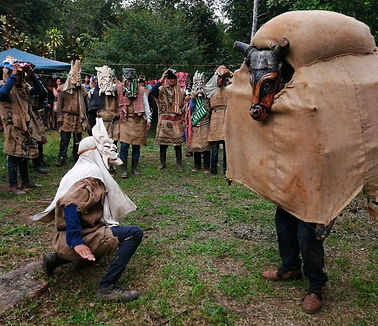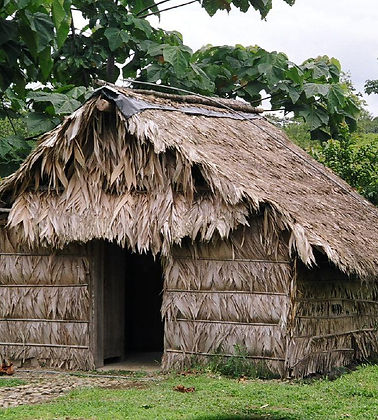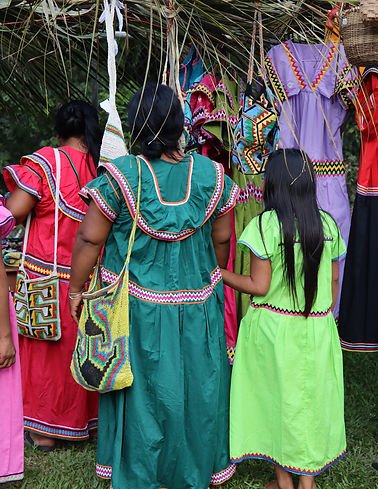


© 2035 by The Clinic. Powered and secured by Wix

Indigenous Communities of Costa Rica
Costa Rica is home to diverse indigenous communities that have preserved their identity, traditions, and ancestral knowledge over time.
In this section, we invite you to learn more about each town.
 |  |  |  |
|---|---|---|---|
 |  |  |  |
01

Bribrí Village
Location: They live in the province of Limón, in the Talamanca and Puntarenas area.
Territories: Talamanca Bribri, Watsi, Keköldi, Cabagra, Salitre, and Kashabri.
Communities participating in the project: Watsi, Kashabri, and Salitre.
Cultural Fact: Their language, Bribri, reflects a deep connection with nature, as people's names are often derived from environmental elements, such as rivers or animals. They are also notable for their matrilineal system, in which inheritance and spiritual knowledge are passed on through women.
Handicrafts: They make woven basketry, jewelry made from seeds and natural fibers, bags made from cabuya and pita, musical instruments, and textiles.
02
Brörán Village
Location: They are located in the province of Puntarenas, specifically in Buenos Aires, in the southern region.
Territories: Térraba.
Communities participating in the project: Térraba.
Cultural Fact: Despite external influence, the Térraba maintain their organizational structure based on the council of elders, responsible for making community decisions. Their culture is distinguished by a strong tradition of struggle in defense of their lands and the preservation of their language.
Handicrafts: They make jewelry such as necklaces, earrings, dreamcatchers, and bracelets. Everything is handmade with natural materials: seeds, stones, and pieces of wood. They also carve and color gourds, as well as woodcuts.

03

Brunka Village
Location: They are found in southern Costa Rica, in the province of Puntarenas, specifically in Buenos Aires and Osa.
Territories: Boruca and Rey Curré.
Participating communities in the project: Boruca and Rey Curré.
Cultural Fact: They are famous for the Dance of the Devils, a festival in which the fights between the indigenous people and the Spanish conquistadors are represented through hand-carved masks.
Handicrafts: They are known for their wooden masks, decorated with vibrant colors and animal designs. They also make gourds and cotton fabrics using traditional techniques, such as bags and purses.
04
Cabécar Village
Location: Located in Buenos Aires, Puntarenas, and in the mountains of the Talamanca Cordillera, between Limón and Cartago.
Territories: Talamanca Cabécar, Bajo Chirripó, Tayní, Telire, Ujarrás, La Palma, Nairir Awari, and China Kichá.
Communities participating in the project: Bajo Chirripó, Ujarrás, and Talamanca Cabécar.
Cultural Fact: They are one of the most isolated Indigenous communities in Costa Rica, which has allowed them to preserve their language and traditions in a pure way. Their close relationship with nature is reflected in their conical-shaped homes and their spiritual worldview.
Handicrafts: They work in basketry with natural fibers, mobiles, and wood carving, woven paintings with floral motifs, figures with mastate, and the creation of traditional musical instruments.

05

Chorotega Village
Location: They live in the province of Guanacaste, in the northwest of the country.
Territories: Matambú, San Vicente de Nicoya, and Las Posas.
Communities participating in the project: San Vicente de Nicoya and Matambú.
Cultural Fact: They are famous for their pottery, which preserves the ancestral designs and techniques of their Mesoamerican ancestors. Our ecomuseum is located in the town of San Vicente, on the Nicoya Peninsula, while there are also Chorotega communities in Nicaragua and Chiapas, Mexico.
Handicrafts: Their pottery is highly recognized and is characterized by its natural colors and geometric designs inspired by pre-Columbian culture.
06
Huetar Village
Location: Their population is primarily found in the central region of the country, specifically in San José, Mora, and Puriscal. Also in Alajuela.
Territories: Quitirrisí and Zapatón.
Communities participating in the project: Quitirrisí
Cultural Fact: Although their original language has been lost, many Huetar words have been incorporated into Costa Rican Spanish, such as "tucurrique" and "barva." Although their language has become extinct, they have maintained many of their traditions, such as pottery and the use of medicinal plants.
Handicrafts: They make baskets woven from rattan, basketry made from estococa palms, woven palm jewelry, woven paintings, purses, hats, natural dyes, and clay pieces: ocarinas (depicting fauna), pots, and ceremonial incense burners.

07

Maleku Village
Location: They live in the northern region of the country, in the province of Alajuela, specifically in San Rafael de Guatuso.
Territories: Palenque El Sol, Margarita, and Tonjibe.
Communities participating in the project: Palenque El Sol, Margarita, and Tonjibe.
Cultural Fact: They are known for their deep respect for flora and fauna, reflected in their tradition of asking permission from the spirit of a tree before cutting it down. They are also noted for their skill in making drums and flutes, as well as for their efforts to preserve their language, Maleku Jaica.
Handicrafts: They create wooden masks, musical instruments such as drums, maracas, and rain sticks, balsa carvings in the shapes of sacred animals, wallets and purses made from gourds, and hammocks made from cabuya and wicker. They also make ornaments made and carved from gourds.
08
Project name
Location: They live in the southern part of the country bordering Panama. They live in the province of Puntarenas, specifically in Buenos Aires, Coto Brus, Corredores, Golfito, Punta Burica, and Osa, in the area bordering Corcovado National Park.
Territories: Osa, Conte Burica (Punta Burica), Alto Rey (Abrojo Montezuma), Alto de San Antonio, Coto Brus, Abrojos, Alto Río Claro, Altamira, Progreso, and Casona.
Communities participating in the project: Conte Burica (Punta Burica), Alto Rey (Abrojo Montezuma), Alto de San Antonio, and Coto Brus.
Cultural Fact: Their culture is distinguished by their colorful traditional attire, where women wear long tunics called "naguas" (sleeping gowns) adorned with geometric designs. They also preserve the traditional "krun krun" dance, which they perform during special celebrations.
Handicrafts: They make chaquiras (necklaces and bracelets made of colorful beads), dolls of various animals, woven with pita fiber, palm basketry, rag dolls called "Mamitas," mastates with animal motifs, textiles such as clothing, hats, and chacras (bags made of pita or burillo).
